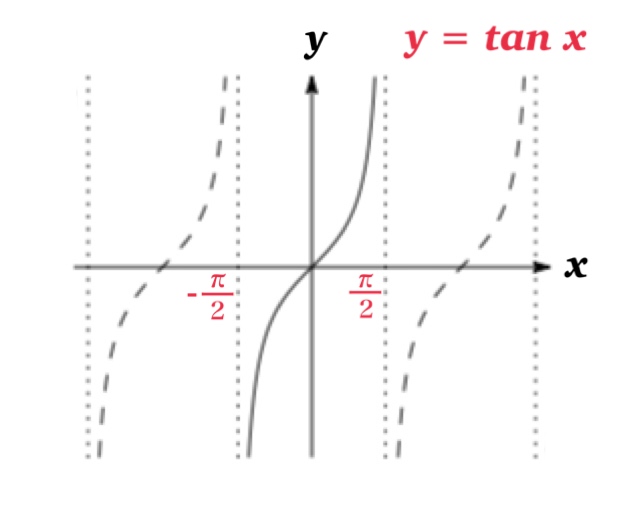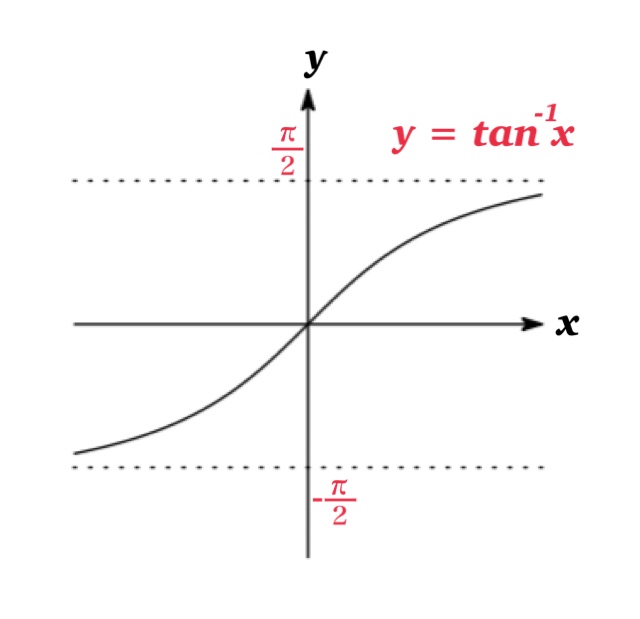We define \(y=\tan^{-1} x\) to be the inverse function of \(y=\tan x\). That is
$$y=\tan^{-1} x \ \ \Longleftrightarrow \ \ x=\tan y$$
Note that \(y=\tan x\) is not one to one, therefore we restrict the interval on \(-\frac{\pi}{2}\leq x \leq\frac{\pi}{2}\).
Then, the graph of \(y=\tan x\) on the interval \([-\frac{\pi}{2}, \frac{\pi}{2}]\) is one-to-one, and the range of the function \(y=\tan x\) is \(-\infty\leq y \leq\infty\).


Then we define the inverse function of this restricted tangent function which is denoted by \( \tan^{-1} x \) or \(\arctan x \).
The domain of the function \(y=\tan^{-1} x\) is defined on \(-\infty\leq x\leq \infty\) which is the range of \(y=\tan x\), and the range of the function \(y=\tan^{-1} x\) is \(-\frac{\pi}{2}\leq x\leq \frac{\pi}{2}\).


Exanple:Evaluate \(\tan^{-1}\sqrt{3},\ \tan^{-1}(\frac{\sqrt{3}}{3})\), and \(\cos^{-1}(-\sqrt{3})\).
Solution: We have $$\tan^{-1}\sqrt{3}=\frac{\pi}{3},\ \ \tan^{-1}(\frac{\sqrt{3}}{3})=\frac{\pi}{6},\ \ \ \text{and}\ \ \ \tan^{-1}(-\sqrt{3})=-\frac{\pi}{3}$$
since \(\tan(\frac{\pi}{3})=\sqrt{3}, \tan(\frac{\pi}{6})=\frac{\sqrt{3}}{3}\) and \(\tan(-\frac{\pi}{3})=-\sqrt{3}\).
Notice that \(\tan^{-1}(-x)=-\tan^{-1} x\).
Derivative of \(y=\tan^{-1} x\)
\begin{eqnarray*}&&\frac{d}{dx} (\tan^{-1} x)=\frac{1}{1+x^{2}}\\
&&\frac{d}{dx} (\tan^{-1} f(x))=\frac{f'(x)}{1+f(x)^{2}}\end{eqnarray*}
Let \(y=\tan^{-1} x\). Then \(y=\tan^{-1} x\) if and only if \(x=\tan y\) where \(-\frac{\pi}{2}\leq y\leq \frac{\pi}{2}\).
Therefore, by implicit differentiation
$$\begin{eqnarray*}\frac{d}{dx}(\tan^{-1} x)&=&\frac{dy}{dx}=\frac{1}{\ \ \frac{dx}{dy}\ \ }\\&=&\frac{1}{\frac{d}{dy}(\tan y)}=\frac{1}{\ \frac{1}{\cos^{2}y}\ }\\&=&\frac{1}{1+\tan^{2} y}=\frac{1}{1+x^{2}}\end{eqnarray*}$$
So, we have shown that
$$\frac{d}{dx} (\tan^{-1} x)=\frac{1}{1+x^{2}}$$
By applying the Chain Rule, we have
$$\frac{d}{dx} (\tan^{-1} f(x))=\frac{f'(x)}{1+f(x)^{2}}$$
Example
Find \(F'(x)\) if \(F(x)=\tan^{-1}3x^{2}\).
Solution: \(F'(x)=\frac{1}{1+(3x^{2})^{2}}\frac{d}{dx}(3x^{2})=\frac{6x}{1+9x^{4}}\).
Integration
By the derivatives formula, we have integration formulas as below:
\begin{eqnarray*}&&\int \frac{1}{1+x^{2}}\ dx=\tan^{-1}x +C \\
&&\int \frac{1}{a^{2}+(px+q)^{2}}\ dx=\frac{1}{ap}\tan^{-1}\frac{px+q}{a} +C\end{eqnarray*}
To evaluate \(\int \frac{1}{\sqrt{a^{2}+(px+q)^{2}}}\ dx\), we rewrite as the following:
\begin{eqnarray*}\int \frac{1}{a^{2}+(px+q)^{2}}\ dx&=&\int \frac{(\frac{px+q}{a})’\cdot \frac{a}{p}}{a^{2}\{1+(\frac{px+q}{a})^{2}\}}\ dx\\&=&\int \frac{1}{ap}\cdot \frac{(\frac{px+q}{a})’}{1+(\frac{px+q}{a})^{2}}\ dx\\&=&\frac{1}{ap}\tan^{-1}(\frac{px+q}{a})+C\end{eqnarray*}
Or substituting \(\frac{px+q}{a}=t\), we have \(\frac{dt}{dx}=\frac{p}{a}\) and \(dt=\frac{p}{a}dx\). Then
\begin{eqnarray*}\int \frac{1}{a^{2}+(px+q)^{2}}\ dx&=&\frac{1}{ap}\int \frac{1}{1+(\frac{px+q}{a})^{2}}\ \frac{p}{a}dx\\&=&\frac{1}{ap}\int \frac{1}{1+t^{2}}\ dt\\&=&\frac{1}{ap}\tan^{-1} t +C\\&=&\frac{1}{ap}\tan^{-1}(\frac{px+q}{a})+C\end{eqnarray*}
Example
Evaluate \(\int \frac{x}{x^{4}+x^{2}+1}\ dx\)
Solution: To apply the integration formula, we rewrite \(\frac{x}{x^{4}+x^{2}+1}\) as below:
\begin{eqnarray*}\frac{x}{x^{4}+x^{2}+1}&=&\frac{x}{(x^{4}+2x^{2}+1)-x^{2}}\\&=&\frac{x}{(x^{2}+1)^{2}-x^{2}}\\&=&\frac{x}{(x^{2}-x+1)(x^{2}+x+1)}\\&=&\frac{1}{2}\left(\frac{1}{x^{2}-x+1}-\frac{1}{x^{2}+x+1}\right)\end{eqnarray*}
Thus, we have
\begin{eqnarray*}\int \frac{x}{x^{4}+x^{2}+1}\ dx&=&\int \frac{1}{2}\left(\frac{1}{x^{2}-x+1}-\frac{1}{x^{2}+x+1}\right)\ dx\\&=&\frac{1}{2}\left( \int \frac{1}{(x-\frac{1}{2})^{2}+(\frac{\sqrt{3}}{2})^{2}}\ dx -\int \frac{1}{(x+\frac{1}{2})^{2}+(\frac{\sqrt{3}}{2})^{2}}\ dx\right)\\&=&\frac{1}{\sqrt{3}} \left(\tan^{-1}\frac{2x-1}{\sqrt{3}}-\tan^{-1}\frac{2x+1}{\sqrt{3}} \right)+C\end{eqnarray*}